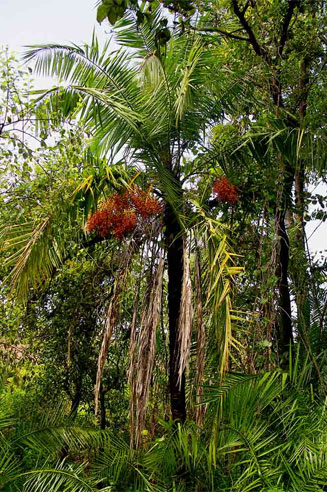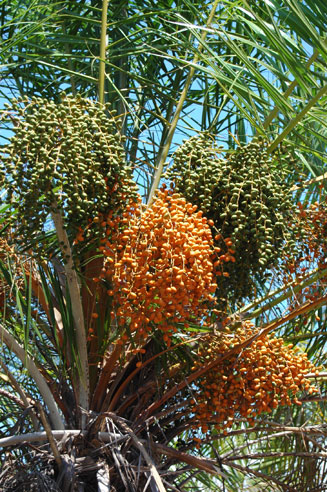|
Phoenix reclinata (Wild date
palm)
Wildedadelboom [Afrikaans]; iSundu [Xhosa]; liLala [Swazi];
Mutzhema, Mutshema, Mutshevho [Venda]
Life
> eukaryotes >
Archaeoplastida >
Chloroplastida
>
Charophyta > Streptophytina > Plantae (land plants)
> Tracheophyta (vascular plants) > Euphyllophyta > Lignophyta (woody plants)
> Spermatophyta (seed plants) > Angiospermae (flowering
plants)
> Monocotyledons > Order: Arecales > Family: Arecaceae
> Genus: Phoenix
 |
 |
|
Phoenix reclinata in fruit on the Zambian
side of Victoria Falls. [photo Helen Pickering ©,
Flora
of Zimbabwe] |
Phoenix reclinata, Mozambique. [photo John E. Burrows ©] |
 |
|
Phoenix reclinata, Victoria Falls National
Park, Zimbabwe. [photo Bart Wursten ©,
Flora
of Zimbabwe] |
This palm is in the same
genus as the Date palm and its fruit are
similar to the latter except smaller and lacking the thick flesh. It grows to a
height of usually 3-6 m although trees can reach 10 m high. It has a very
characteristic growth-form with several trunks originating from a common base
with the lateral trunks leaning far over but curving upwards terminally.
Distribution and habitat
The native distribution of this species extends from
tropical Africa southwards down the east coast of southern Africa to the
Bathurst district in the Eastern Cape. Within southern Africa is is native to
northern Namibia, northern Botswana, Zimbabwe, Mozambique, Swaziland, Limpopo,
Mpumalanga, KwaZulu-Natal and the Eastern Cape.
Trees usually grow along river banks in low-lying
open grassland (Palgrave and Palgrave 2002).
Ecological interactions
- Fruit are eaten by:
- birds (e.g. mousebirds)
- mammals
- Soft shoots are eaten by:
- Leaves are eaten by:
Uses
- Fruit are edible and unsurprisingly taste rather like dates.
- The sap is tapped by local people to make palm wine. The tapping is
usually done from the flower stalk just before flowering commences when sap
flow is at its height (Palgrave and Palgrave 2002).
- Brushes and brooms are made from stem fibres.
- In Kosi Bay (KwaZulu-Natal), the midribs of leaves are used to make fish
kraals.
- The apices of young stems are eaten.
- Baskets are made from the leaves.
- Spines on the base of the leaves are evidently used medicinally (how)?
- Commonly grown as a garden ornamental tree. For instance there are a
number of trees in the Company Gardens in Cape Town and Arderne Gardens in
the Cape Town suburb of Claremont.
References
- Palgrave, K.C. and Palgrave, M.C. 2002. Trees of Southern Africa.
3rd Edition. Struik Publishers, Cape Town.
- Palmer, E. and Pitman, N. 1972. Trees of Southern Africa covering
all known indigenous species in the Republic of South Africa, South-West
Africa, Botswana, Lesotho and Swaziland. Volume 1. A.A.
Balkema, Cape Town.
- van Wyk, B. and van Wyk, P. 1997. Field Guide to Trees of
Southern Africa. Struik Publishers, Cape Town.
Text by Hamish Robertson |
